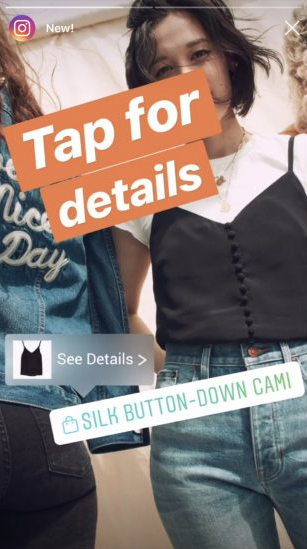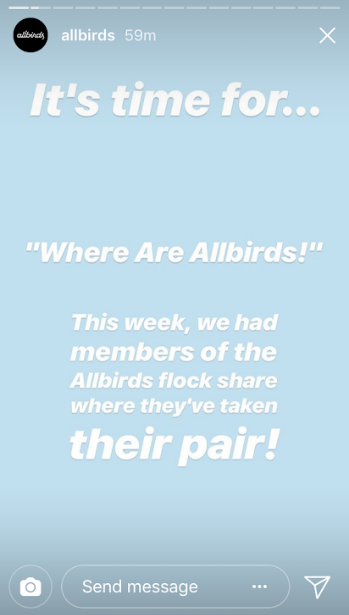No social media marketing strategy is complete without Instagram. But there is much more to Instagram than just uploading pictures and videos to your profile.
With a standard post, you’re somewhat limited to how much content you can upload in a given day or a week.
Let me clarify. Technically, you can post as much as you want. But that strategy won’t work.
On average, most brands post about 10 times per week. Uploading content more than once or twice per day to your Instagram profile will have a negative impact.
According to a recent study from Sprout Social, 58% of consumers say it’s annoying when brands post too much on social media. And 46% of users will unfollow a brand for doing this.
But you want to share your content with your audience. Sometimes, posting once or twice per day isn’t enough to get your point across.
That’s when you should be leveraging your Instagram story.
Unlike a traditional post, your Instagram story won’t flood the timelines of your followers. You can upload more than ten pictures or videos to your story, and it won’t hinder anyone’s experience. This isn’t the case with posts posted directly to your profile.
Instagram has more than 400 million daily active users. One-third of the stories with the most views are uploaded by businesses.
Taking advantage of this feature is a great opportunity for your brand to generate sales on Instagram.
It’s worth mentioning that the longer your Instagram story is, the less of a chance it has of being watched in its entirety:

That said, nearly 60% of people will watch your entire story that has 20 frames.
That’s more content than you would upload with traditional posts to your profile in an entire week.
You can create a new Instagram story every day since the old stories disappear after 24 hours. This means you get to start off each day with a clean slate.
There are many different approaches to Instagram stories that drive sales. That was my inspiration for writing this guide.
I’ve identified some of the best examples of Instagram stories from a wide range of brands. Using these approaches in your Instagram posting strategy will help you avoid stale content for upcoming posts.
This is the approach you need to take if you want to generate more sales on Instagram.
Set up a shoppable story
For years, in order for businesses to directly drive sales on Instagram, they had to rely on adding links to their bios to drive followers to product landing pages.
That was ineffective since the user had to take too many additional steps.
But Instagram recently rolled out an update allowing brands to increase product sales with shoppable posts.
With a shoppable post, you can tag products in an image, the same way you would a person. When a user clicks on the tag, they are directed to a landing page that gives them the opportunity to buy what you’re selling.
Clicking on a shoppable tag has far less friction than having to navigate to your bio.
While many brands are taking advantage of shoppable posts, many don’t realize they can also use shoppable stories.

The same concept applies here.
On your story, just tag an item from your product catalog. Users who view the story will have an option to click on the tag and be directed to a page where they can complete the purchase.
If you want to directly drive sales, this is one of your best options.
You can add dozens of different products to your Instagram shoppable story. Or maybe you’ll take another approach and use your entire story to promote one product.
Whichever option you choose, you’ll be able to generate more sales with these strategies.
Run a poll
Polls on Instagram stories are a great way to drive engagement.
Unlike with a shoppable post, participating in a survey won’t directly drive sales, but it will still pique your followers’ interest.
Polls can triple your engagement metrics on a story.
That’s because they are easy. All a user has to do is click on one of the two options to participate. Plus, that’s the only way they’ll be able to see how other people have voted.
Here’s an example of how Microsoft Surface used this strategy in a sponsored story:

It’s a very simple question.
They’re asking what’s more important to users, power or portability?
Here’s the catch. When users swipe up, following the “learn more” CTA, they’ll discover this product has both power and portability.
You’ll see more of this swipe up style CTAs throughout this guide.
Take advantage of the swipe up feature.
According to a case study from Marketing Land, 15-25% of users who see these links on Instagram stories are swiping up.
MeUndies participated in this study.
On average, 20% of users who saw its story swiped up to learn more. And 90% of those people have never visited the website before.
Adding a poll to your story increases your chances of getting higher engagement rates and, hence, makes it more likely that users will click your CTA. You’ll be able to generate more sales as a result.
Showcase testimonials to increase brand credibility
Testimonials are one of the best ways to increase credibility of your brand, products, and services.
In fact, 92% of consumers refer to testimonials when making a purchase decision.
Further, 88% of consumers trust a testimonial as much as a recommendation from someone they know. And 72% of buyers say they trust a business more after reading a positive testimonial about it.
Adding a testimonial to your story will definitely increase your chances of driving sales.
Here’s a great example from Mack Weldon:

It used a testimonial from Men’s Health to add credibility to its product.
If a reputable magazine such as Men’s Health says this is the best underwear for the gym, then they must be, right? That’s the idea behind this testimonial.
As you can see, Mack Weldon is also taking advantage of the swipe up feature.
By clicking this CTA, users will have a chance to buy products directly from the landing page. This process limits friction, which improves conversion rates.
It’s much more effective than asking your followers to navigate to your website by opening a separate web browser. Conversion rates for that method would be much lower.
Partner with a social influencer
You can also use influencers to increase your product’s credibility.
This strategy works for the same reasons as testimonials do. Followers will see a promotion from someone whom they trust and follow their recommendation as a result.
With influencer marketing, you don’t even need to post any content on your story.
Instead, you can have the influencers with whom you’re working promote your brand with their own stories.
Take a look at how CALIA by Carrie uses this strategy:

CALIA by Carrie partnered with professional surfer and model Anastasia Ashley.
Anastasia shares this content on her own story, so it’s viewed by her followers. Now people who may have never heard of this brand are exposed to the promotion.
This strategy is a great opportunity for you to increase your reach.
With this widened exposure, you’ll have a better chance of getting more followers and increased website traffic. Both of these metrics can help you drive sales.
Encourage interactivity
This strategy is similar to that of the story polls, which I talked about earlier.
The whole idea behind encouraging interaction with your followers is they engage with your content. Keeping people engaged will help your brand, products, and services stay fresh in their minds.
Check out this example from Tropicfeel:

Tropicfeel is a startup company that makes the ultimate travel shoe. All of their promotions target people who like to travel.
Everyone travels for different reasons.
Adding this content to its story gave users a chance to share their answers about their travel preferences.
The level of engagement it takes to complete this survey is much higher than just clicking on a poll.
A user has to take a screenshot, then add the same image to their own story with their answers circled.
Then, Tropicfeel shared those responses back on its original story:

It’s a clever strategy.
If you plan on doing something like this, you can’t expect the participation rates to be extremely high. That’s because it takes extra effort.
But it’s still effective. Even if some followers aren’t participating, they’re watching the story to view responses from other people.
All of this makes the company’s target audience think about traveling and potentially planning their next trip.
Maybe its followers need new shoes before their next excursions, which would entice them to make a purchase from this brand.
Repurpose user-generated content (UGC)
In the last example, you also saw repurposed user-generated content.
The only difference is it was produced as part of a campaign. But that doesn’t have to be the case.
There will be instances when your customers tag you in their stories without any encouragement from you.
Maybe they put on a new pair of sunglasses they just ordered from your ecommerce shop and want to show them off to their followers. So they upload an image to their story and tag your brand.
You’ll be notified any time your brand is tagged in a story. From here, you’ll have the option to share that same content to your own story as well.
Look at how Patara Shoes uses this tactic:

Repurposing UGC accomplishes several things.
First, this type of content will have the same effect as a customer testimonial, which I previously discussed.
Sharing a story like this also shows your followers you’re willing to repost content your brand is tagged in. This gives them some encouragement to do the same for a chance to be featured.
With more of your followers posting about your brand on their personal profiles, you end up getting social influencers free.
These people may not have thousands of followers as the influencers whom you’re paying, but their content is still valuable and can lead to additional sales from anyone who sees their stories.
Follow a progression
Earlier I talked about how you can upload lots of frames to your story each day, which isn’t recommended for a traditional post.
But the frames shouldn’t be random.
If you refer to some of the examples you looked at so far today, you wouldn’t want to combine all of them into one story.
I see brands make this mistake all the time. They forget that their Instagram story should actually tell a story. This means it needs to follow a logical progression.
Here’s an example from Thule:

The story starts with a date.
This will grab the attention of anyone watching and make them curious as to what’s happening on this date.
As a result, they’ll continue watching to learn more information:

As the story continues, they’ll learn there will be some type of celebration.
Users will continue on:

Now things start to get more specific.
Thule shares the time of the celebration and hints at a product launch.
This story had seven frames. We looked at just three.
Imagine if all three of these frames were combined into one. That would be way too much text on the screen.
Now imagine if seven frames of text were crammed into just one.
It would be overwhelming and difficult for people to read. The message would be lost.
A progression like this makes it easier for people to consume it and more likely that they will do that.
If you’re trying to introduce a new product or event to drive sales, you can do it over several images or videos as opposed to just one.
I’ll show you another example of this type of progression below.
Introduce your team
I love the idea of showing your employees on your Instagram story.
This concept adds a human element to your brand, which goes a long way. It allows your followers to see you’re more than just a company. Real people they can relate to are the driving force behind your operation.
Let’s look at how Allbirds did this on its Instagram story:

As you can see, this story follows a progression as well.
Instead of showing its employees out of context, the company starts the story by saying it wants to share images of where the team has gone with the product.
Here’s one example from the dozen or so posted:

Maria, an employee from the supply chain team, wore the company’s product to the Great Wall of China.
This story shows that its employees stand behind their products. They own them and actually use them.
But if you don’t have this type of content to share on your story, it doesn’t mean you can’t introduce your team.
Another way to do this is by showing behind-the-scenes looks at your operation.
Any time an employee achieves something, you could share that accomplishment on your story.
Again, this strategy will humanize your brand and make you more relatable to your followers. These types of posts are perfect for your story.
Promote a new product launch
As I said earlier, you don’t want to flood the timelines of your followers with promotions all the time.
This is annoying and will eventually cause people to unfollow you.
But if you have a new product coming out soon, it’s a big deal. You want to start promoting it as soon as possible. That way, your customers are ready for it by the time it’s released.
Use your story to accomplish this.
Here’s a simple example from Vuori Clothing:

It’s a great way to use the 2018 holiday season to drive sales.
You can go into greater detail about your products in your story, depending on what you’re promoting.
For example, you could upload a video tutorial to your story showing how to use the new product.
Combine this strategy with some of the other tactics on this list and have a social influencer do the same thing for you.
Building hype for your products before they launch increases your chances of generating sales when they finally become available for purchase.
Conclusion
Instagram has become a powerful tool for brands. But that’s only the case if you’re taking advantage of all the features available.
Simply posting content to your profile isn’t enough. Plus, you should be uploading only one or two images or videos each day.
You have much more flexibility with the amount of content you post to your Instagram story.
Promote your products directly by using a shoppable story.
Run a poll and encourage interaction to drive engagement.
By showcasing testimonials, partnering with social influencers, reposting user-generated content, and introducing your employees, you’ll be able to add more credibility to your brand and products.
All of your stories should follow a logical progression.
If you follow the tips and examples I’ve outlined above, your Instagram story will help you generate additional profits.
How is your brand using Instagram stories to drive sales?
Source Quick Sprout https://ift.tt/2Rfm3C6
